 Epistylis on a Schubert's Barb
Epistylis on a Schubert's Barb
2012-02-29, 7:31 pm
Sheet disease
Tray / aquarium:
Tank volume (L) + Dimensions (L x W x H): 120x40x40 (cm3) or about 192 litre with upper area being decreased
How long is it in water: 2 years and 4 months
Do you have a hospital tank for a possible treatment or isolation: Yes
Filtration, the type, weight, flow rate: Top filter x2, @1200 L/h each.
Water and its parameters:
T (° C): 26.5 °C
pH: 7
KH: 4
GH: 7
NO2: 0
NO3: 50
Conductivity (microseconds): -
Preparation and water change (how, how much and how often): 30% water change each week.
Supply (what / range / brand, how much, how many times / day): 1/3 tsp TetraBits Complete & 1 tablet Sera Spirulina in the morning, live bloodworm at night.
Has there been a change in food within 15 days before the first symptoms: No
Has there been a change in the tank in 3 weeks (water parameters, fish, plants, scenery, soil, work near the tank ...)
"The" or "the" disease since the initial water and the treatments carried out: No
The patient or they patients
the Variety, approximate age,
Puntius semifasciolus var Schubert, since about April 2009 (approximately 3 years old.)
Size: approximately 3.5 cm.
symptom :
Have you noticed, one behavior, all that seems abnormal, your overall impression (very important): reddish sore in the body, loose scales, a little bit bloated. Sore area is very slimy when touched.
Tankmates:
Photos or videos of preference for the distribution of a meal "of" or "the" fish involved:
Tank:
See spoiler.
Fish:


Notes:
I've just done a 30% water change yesterday. The fish's behavior is still active and normal, and there is no signs of lack of appetite. One of the tankmates, a Corydoras panda, was found dead at the same time I realized this but not from the same disease. This cory's body showed lethargy signs.
Currently, I am keeping this Schubert's barb in a 21 L isolation tank (60x30x30 tank but only fill 1/3), with 0.5% epsom salt (causing salinity raising to 1.004 level). I suspected this barb got Epistylis sp. infection, which is an ectoparasite. I used George Post's book to identify the disease according to the symtomps, but there was a lack of information on this disease. A further reading about this disease I found at http://www.piclist.com/tecHREF/other/pond/tilapia/epistylis.htm . The website says that this disease is easy to treat. We'll just see about that.
A dead Corydoras panda:

-------------------
Fiche maladie
Plateau / aquarium:
Volume du réservoir (L) + Dimensions (L x P x H): 120x40x40 (cm3) ou environ 192 litres avec coin supérieur étant diminué
Combien de temps est-il dans l'eau: 2 ans et 4 mois
Avez-vous un réservoir d'hôpital pour un traitement possible ou l'isolement: Oui
Filtration, le type, le poids, débit: Haut filtre x2, @ 1200 L / h chacune.
L'eau et ses paramètres:
T (° C): 26,5 ° C
pH: 7
KH: 4
GH: 7
NO2: 0
NO3: 50
Conductivité (microsecondes): -
Préparation changement et de l'eau (comment, combien et à quelle fréquence): 30% d'eau changent chaque semaine.
D'approvisionnement (ce / gamme / marque, combien, combien de fois / jour): 1/3 c TetraBits complet et 1 comprimé Sera Spirulina dans la matinée, vers de vase vivent la nuit.
Y at-il eu un changement dans la nourriture dans les 15 jours avant les premiers symptômes: Aucun
Y at-il eu un changement dans le réservoir en 3 semaines (paramètres de l'eau, les poissons, les plantes, les paysages, les sols, le travail à proximité du réservoir ...)
"Le" ou "la" maladie puisque l'eau initiale et les traitements effectués: Aucun
Les patients des patients ou de leur
la variété, l'âge approximatif,
Puntius semifasciolus var Schubert, depuis environ Avril 2009 (environ 3 ans.)
Taille: environ 3,5 cm.
symptôme:
Avez-vous remarqué, un comportement, tout ce qui semble anormal, votre impression générale (très important): plaie rougeâtre dans le corps, échelles mobiles, un peu bouffi. Zone de Sore est très visqueuse au toucher.
TankMates:
Photos ou vidéos de préférence pour la distribution d'un repas «de» ou «le« poisson impliqués:
Réservoir:
Voir spoiler.
Poisson:


Notes:
Je viens de faire un changement d'eau de 30% hier. Le comportement du poisson est toujours active et normale, et il n'y a aucun signe de manque d'appétit. L'un des cohabitants, un panda Corydoras, a été retrouvé mort dans le même temps, j'ai réalisé cela, mais pas de la même maladie. Ce corps de Cory a montré des signes de léthargie.
Actuellement, je garde cette barbe de Schubert dans un caisson d'isolation sensorielle 21 L (60x30x30 réservoir, mais seulement remplir 1/3), avec du sel d'Epsom 0,5% (salinité provoquant élever à 1,004 niveau). Je me doutais de cette barbe se Epistylis sp. l'infection, qui est un ectoparasite. J'ai utilisé le livre de George Postes à identifier la maladie selon les symtomps, mais il y avait un manque d'information sur cette maladie. Une lecture plus sur cette maladie que j'ai trouvé à http://www.piclist.com/tecHREF/other/pond/tilapia/epistylis.htm. Le site dit que cette maladie est facile à traiter. Nous allons voir à ce sujet.
Un panda morts Corydoras:

Tray / aquarium:
Tank volume (L) + Dimensions (L x W x H): 120x40x40 (cm3) or about 192 litre with upper area being decreased
How long is it in water: 2 years and 4 months
Do you have a hospital tank for a possible treatment or isolation: Yes
Filtration, the type, weight, flow rate: Top filter x2, @1200 L/h each.
Water and its parameters:
T (° C): 26.5 °C
pH: 7
KH: 4
GH: 7
NO2: 0
NO3: 50
Conductivity (microseconds): -
Preparation and water change (how, how much and how often): 30% water change each week.
Supply (what / range / brand, how much, how many times / day): 1/3 tsp TetraBits Complete & 1 tablet Sera Spirulina in the morning, live bloodworm at night.
Has there been a change in food within 15 days before the first symptoms: No
Has there been a change in the tank in 3 weeks (water parameters, fish, plants, scenery, soil, work near the tank ...)
"The" or "the" disease since the initial water and the treatments carried out: No
The patient or they patients
the Variety, approximate age,
Puntius semifasciolus var Schubert, since about April 2009 (approximately 3 years old.)
Size: approximately 3.5 cm.
symptom :
Have you noticed, one behavior, all that seems abnormal, your overall impression (very important): reddish sore in the body, loose scales, a little bit bloated. Sore area is very slimy when touched.
Tankmates:
- Spoiler:
- This tank (120x40x40cm3) has a lot of fish.. Mainly consist of corydoras and pleco.. But there's some other fish..
Front View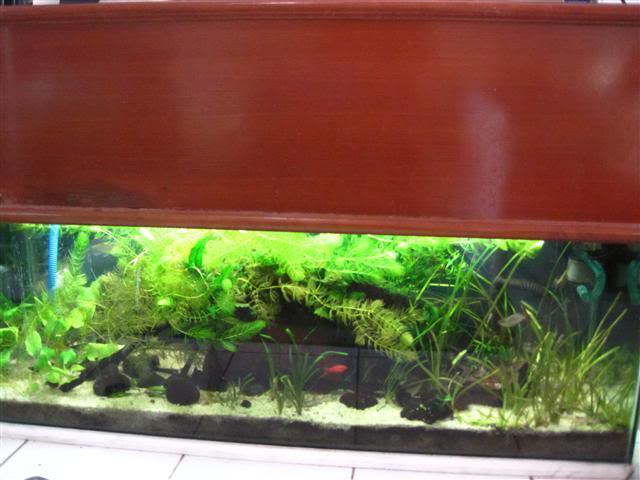
Top View
-------------------------------------------------------
1 Puntius semifasciolus var Schubert
Used to be 2, but 1 died recently because of aging I think (with age of 1 year and 11 months with me)
3 Chery Barb [Puntius titteya]
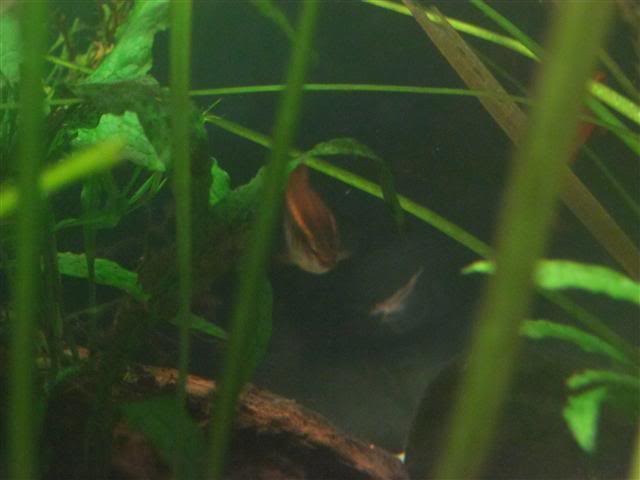
Used to have 12 of them but died one by one along the time.. The remaining are 2 male and 1 female.. I can't get the male photo, so I post not so recent photo of it..
2 Puntius pentazona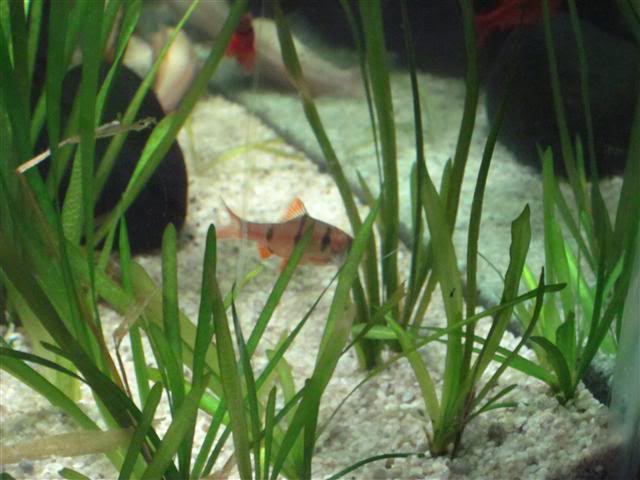
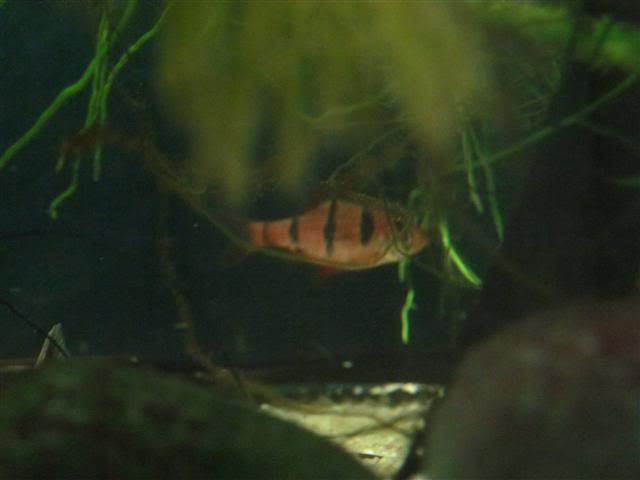
They are very fast moving fish
1 Congo Tetra [Phenacogrammus interuptus]
Used to have 3, but they died a long time ago..
1 Buenos Aires Tetra [Hypesbrycon anisitsi]
I have 5 in total, the other are in the pond.. But this one got pop eyed and can't make it recover. So he's stuck here for further keeping..
1 Swordtail Platy [Xiphophorus helleri]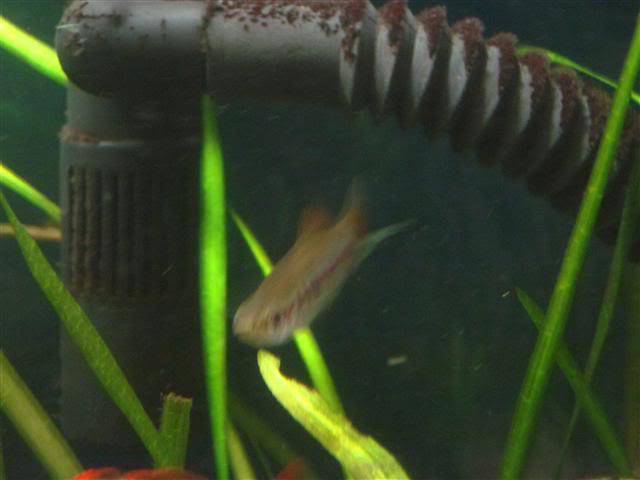
I get this one from when I bought feeder fish for my predator.. The poor fish used to get lernea on his operculum
3 Yoyo Loach [Botia locahata]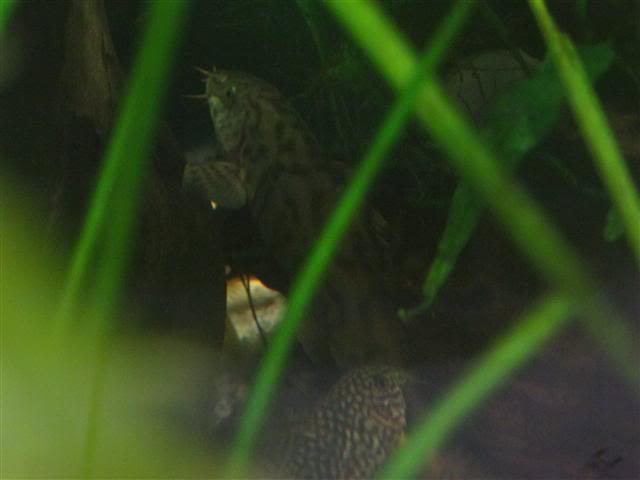

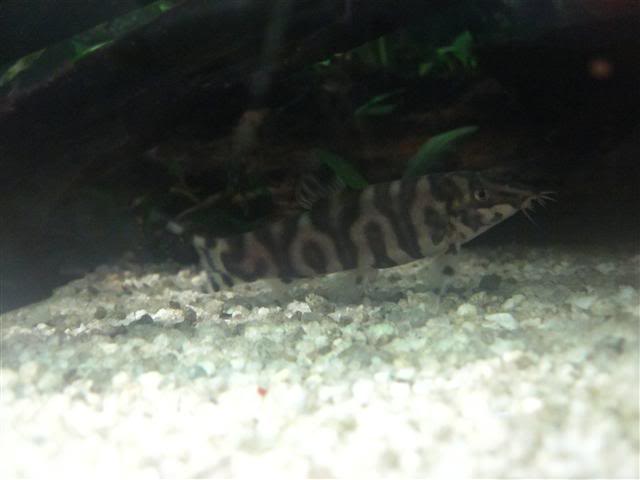
The second and third are not recent photos, it's hard to take a pic on them as they tend to keep hide behind rock..
1 Borneo Sucker [Gastromyzon borneensis]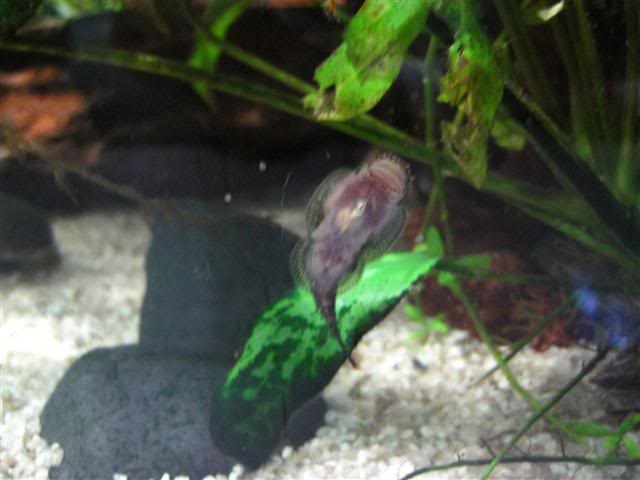
Used to have about 4, this is not a recent photo, haven't found him today. Maybe he's hiding somewhere..
2 Whiptail Lizard Pleco [Rineloricaria sp]
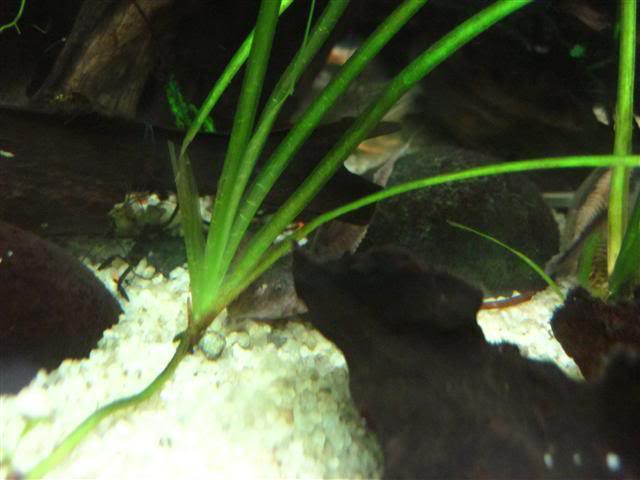
1 Rineloricaria hasemanii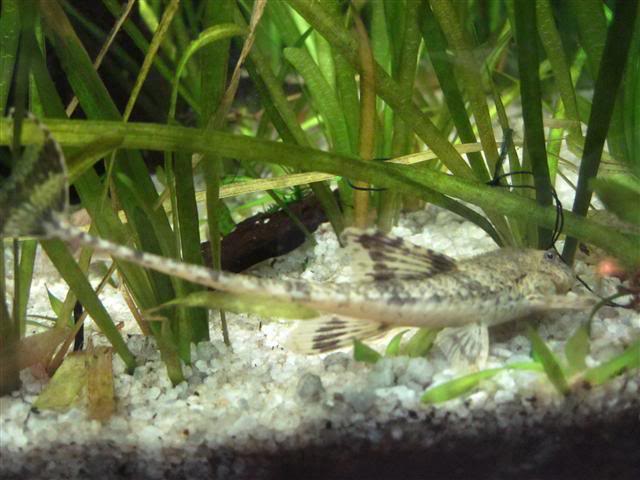
Used to have 2 but 1 died a long time ago.. Don't know what caused it..
2 Rineloricaria eigenmanii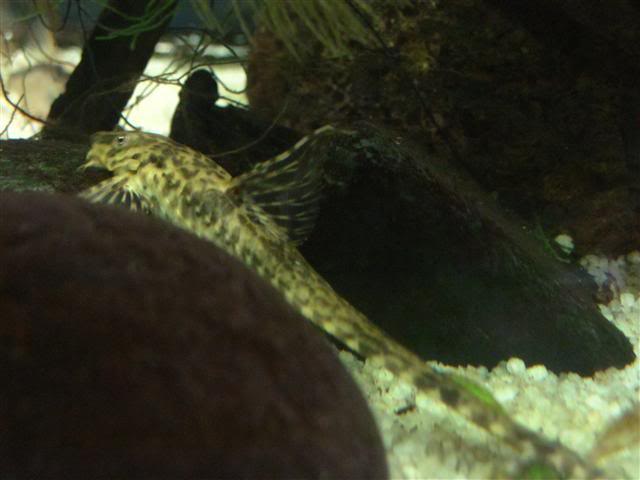
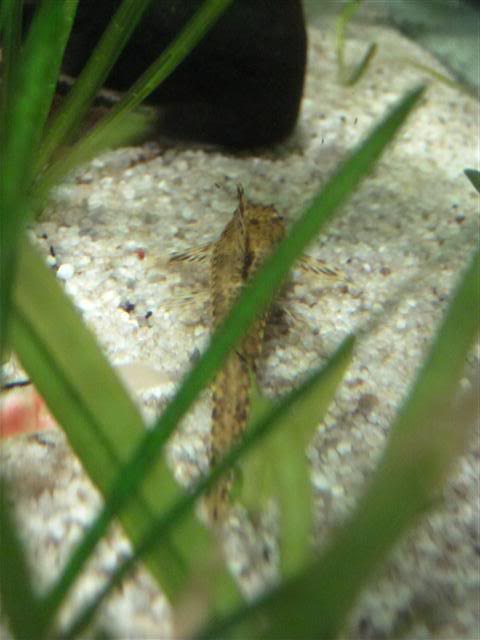
1 Adonis Pleco [Achanticus adonis (L155)]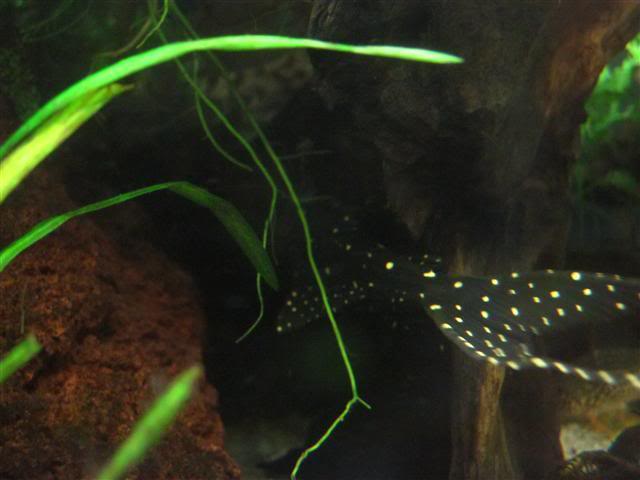
2 Corydoras panda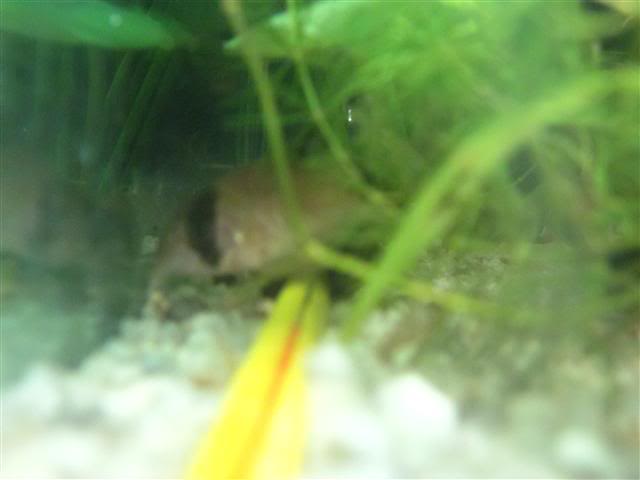
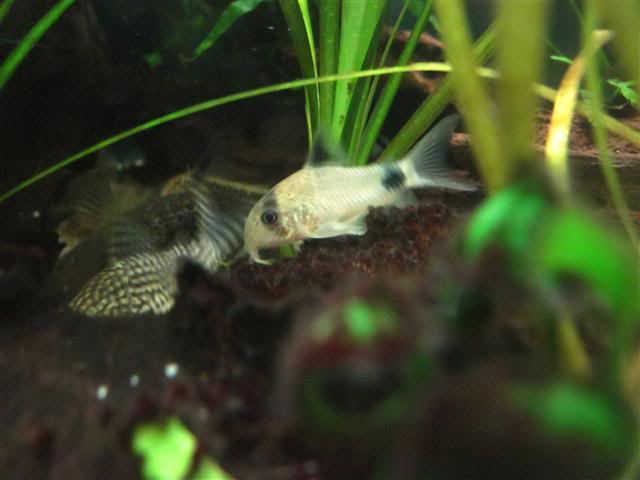
2 Corydoras sterbai

The first photo shows that his right eye is missing, it happens a long time ago, maybe some yoyo loach pecking it..
2 Bronze Corydoras [Corydoras aeneus]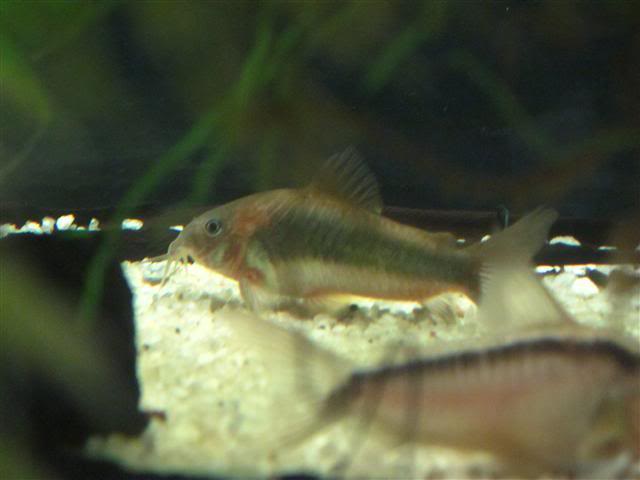
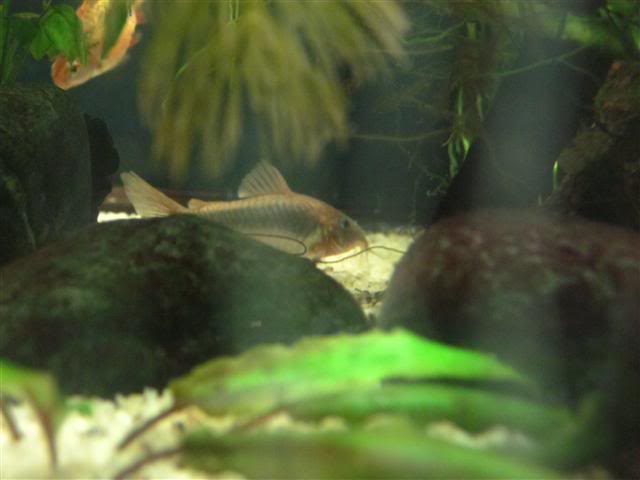
2 "not so" Bronze Corydoras (albino) [Corydoras aeneus]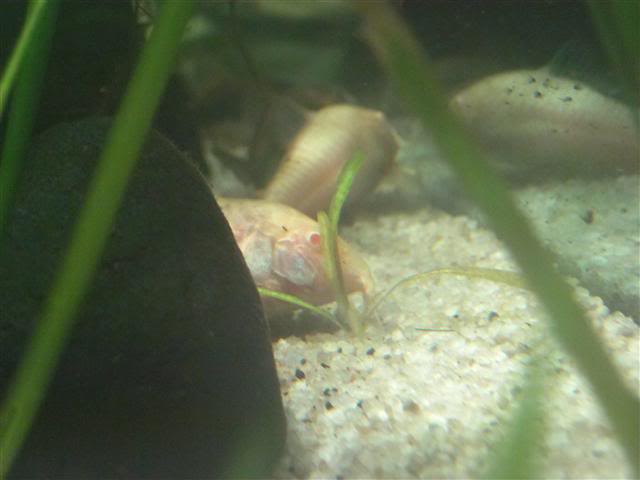
The nearer one quite tend to the left. I don't why it happens about 5 months ago..
1 Bandit Corydoras [Corydoras metae]
It's hard to get this cory, this one is not a very recent photo.. Used to have 2, but died a long time ago..
1 Peppered Corydoras [Corydoras paleatus]
Used to have 2, but 1 died..
2 Corydoras reticulatus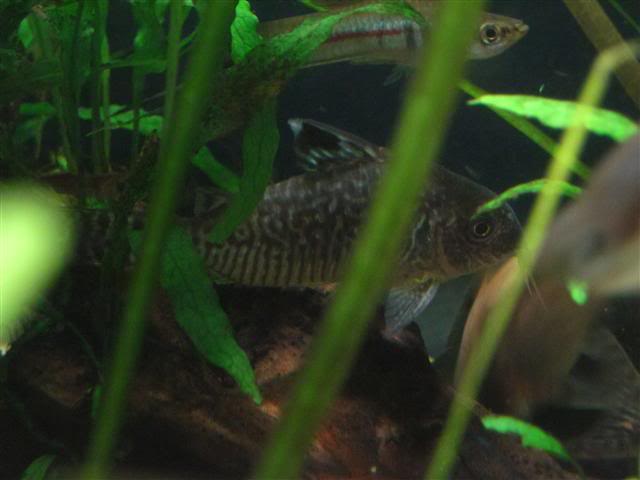
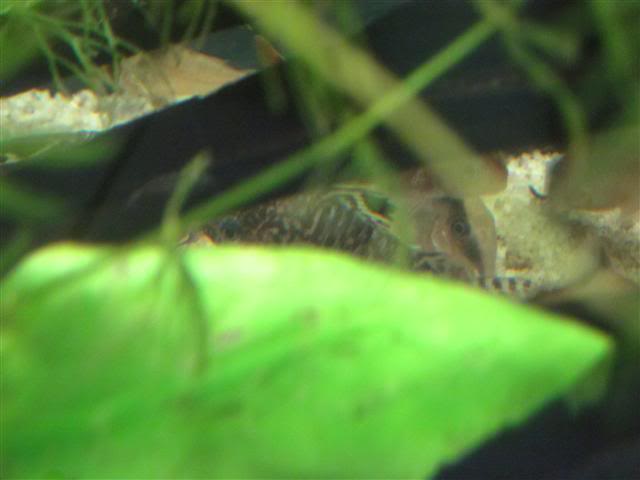
1 Corydoras punctatus
Used to have 3, 2 of them died..
2 Corydoras arcuatus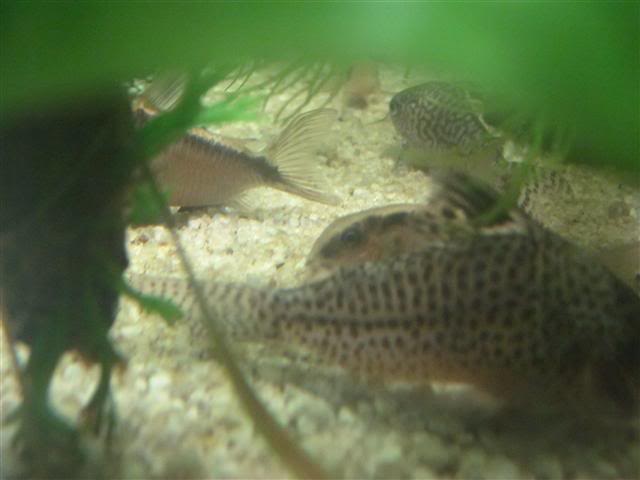
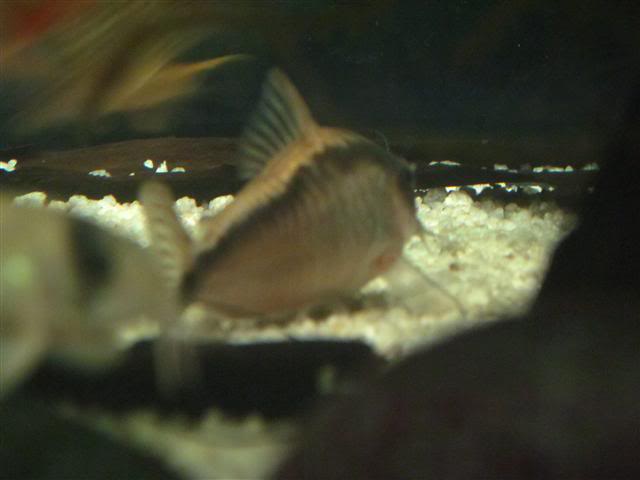
2 Corydoras elegans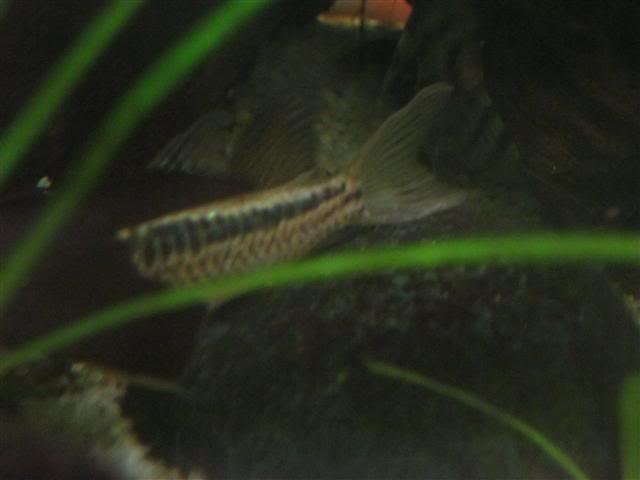
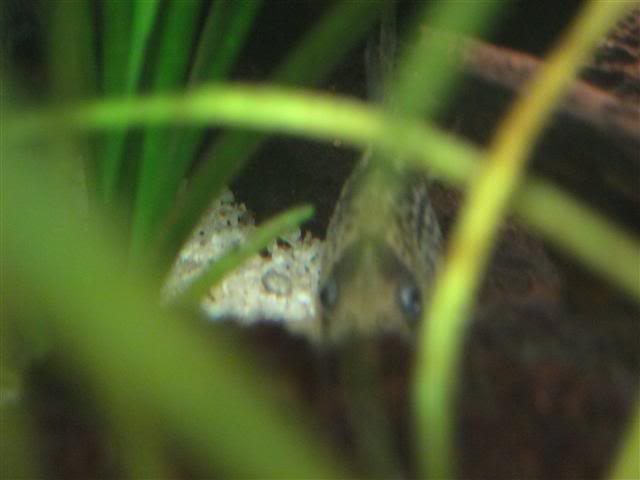
Very hard to catch these fish, it's very active..
2 Corydoras rabauti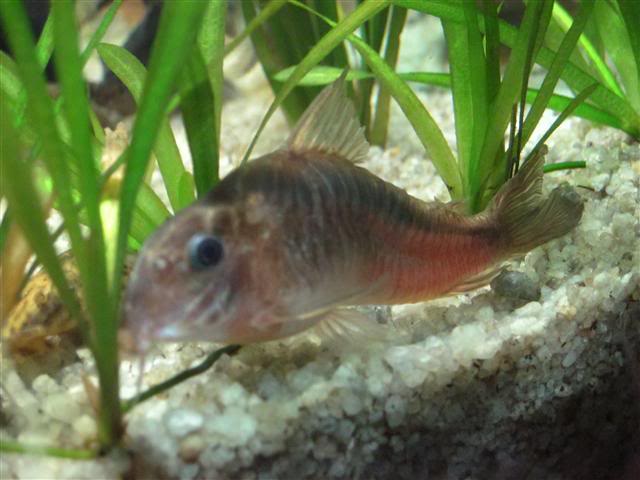

The first one gond bended on it's ventral.. I don't know what caused this.
1 Corydoras brevirostris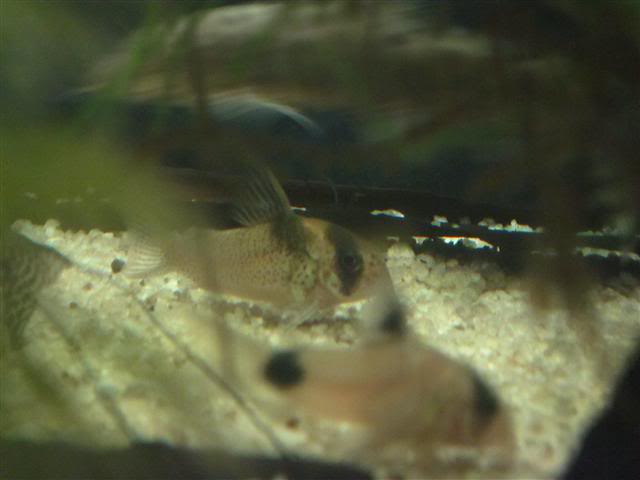
Used to have 2. Died not long after I adopt her..
1 Brochi splendens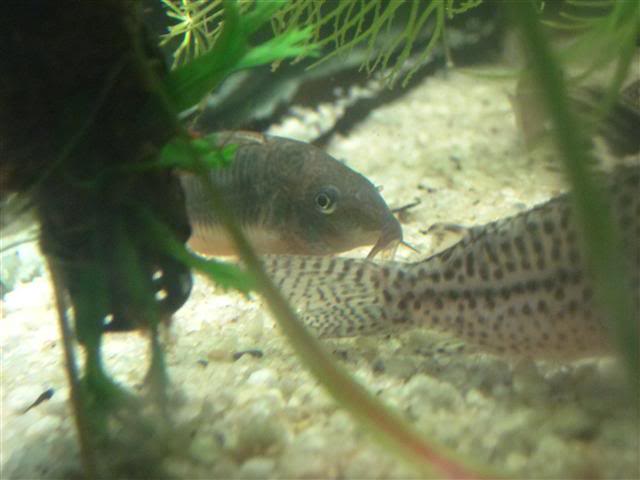
Used to have 2. Died not long after I adopt him..
2 Dwarf Rainbow [Melanotaenia praecox]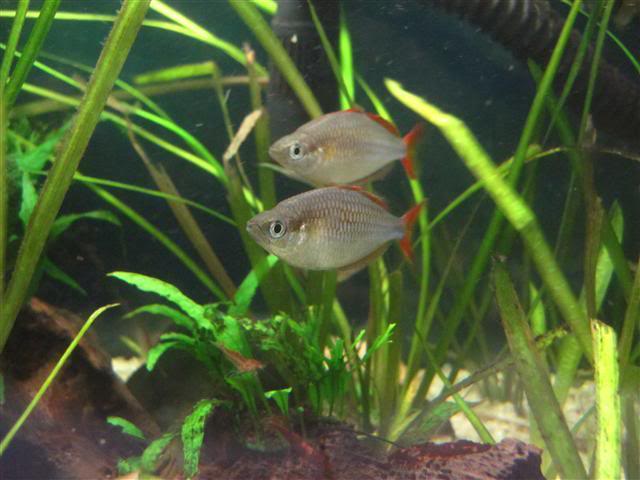
-------------------------------------------------------
The filter using 2x1200L/h top filter + 800L/h for just flows..
Photos or videos of preference for the distribution of a meal "of" or "the" fish involved:
Tank:
See spoiler.
Fish:


Notes:
I've just done a 30% water change yesterday. The fish's behavior is still active and normal, and there is no signs of lack of appetite. One of the tankmates, a Corydoras panda, was found dead at the same time I realized this but not from the same disease. This cory's body showed lethargy signs.
Currently, I am keeping this Schubert's barb in a 21 L isolation tank (60x30x30 tank but only fill 1/3), with 0.5% epsom salt (causing salinity raising to 1.004 level). I suspected this barb got Epistylis sp. infection, which is an ectoparasite. I used George Post's book to identify the disease according to the symtomps, but there was a lack of information on this disease. A further reading about this disease I found at http://www.piclist.com/tecHREF/other/pond/tilapia/epistylis.htm . The website says that this disease is easy to treat. We'll just see about that.
A dead Corydoras panda:

-------------------
Fiche maladie
Plateau / aquarium:
Volume du réservoir (L) + Dimensions (L x P x H): 120x40x40 (cm3) ou environ 192 litres avec coin supérieur étant diminué
Combien de temps est-il dans l'eau: 2 ans et 4 mois
Avez-vous un réservoir d'hôpital pour un traitement possible ou l'isolement: Oui
Filtration, le type, le poids, débit: Haut filtre x2, @ 1200 L / h chacune.
L'eau et ses paramètres:
T (° C): 26,5 ° C
pH: 7
KH: 4
GH: 7
NO2: 0
NO3: 50
Conductivité (microsecondes): -
Préparation changement et de l'eau (comment, combien et à quelle fréquence): 30% d'eau changent chaque semaine.
D'approvisionnement (ce / gamme / marque, combien, combien de fois / jour): 1/3 c TetraBits complet et 1 comprimé Sera Spirulina dans la matinée, vers de vase vivent la nuit.
Y at-il eu un changement dans la nourriture dans les 15 jours avant les premiers symptômes: Aucun
Y at-il eu un changement dans le réservoir en 3 semaines (paramètres de l'eau, les poissons, les plantes, les paysages, les sols, le travail à proximité du réservoir ...)
"Le" ou "la" maladie puisque l'eau initiale et les traitements effectués: Aucun
Les patients des patients ou de leur
la variété, l'âge approximatif,
Puntius semifasciolus var Schubert, depuis environ Avril 2009 (environ 3 ans.)
Taille: environ 3,5 cm.
symptôme:
Avez-vous remarqué, un comportement, tout ce qui semble anormal, votre impression générale (très important): plaie rougeâtre dans le corps, échelles mobiles, un peu bouffi. Zone de Sore est très visqueuse au toucher.
TankMates:
- Spoiler:
- Cette cuve (120x40x40cm3) a beaucoup de poissons .. Principalement composé de corydoras et pleco .. Mais il ya d'autres poissons ..
Vue de face
Vue d'en haut
-------------------------------------------------- -----
1 Puntius semifasciolus var Schubert
Utilisé pour être de 2, mais 1 est mort récemment en raison du vieillissement, je pense (avec l'âge de 1 an et 11 mois avec moi)
3 Barb Chery [ Puntius titteya ]
Utilisé pour 12 d'entre eux ont mais il est mort, un par un au cours du temps .. Le reste sont 2 mâles et 1 femelle .. Je ne peux pas obtenir la photo de sexe masculin, alors je poster photo pas si récente de celui-ci ..
2 Puntius pentazona

Ils sont très rapides poissons qui se déplacent
1 Congo Tetra [ Phenacogrammus interuptus ]
Utilisé pour avoir 3, mais ils sont morts il ya longtemps ..
1 Buenos Aires Tetra [ Hypesbrycon anisitsi ]
J'ai 5 au total, de l'autre sont dans l'étang .. Mais celui-ci se déroulant aux yeux et ne peut pas faire le récupérer. Donc, il est coincé ici pour plus garder ..
1 Swordtail Platy [ Xiphophorus helleri ]
Je reçois celui-ci à partir quand j'ai acheté du poisson d'alimentation pour mon prédateur .. Le pauvre poisson utilisé pour obtenir Lernea sur son opercule
3 Yoyo Loach [ Botia locahata ]


La deuxième et la troisième ne sont pas des photos récentes, il est difficile de prendre une photo sur eux car ils ont tendance à garder cacher derrière roche ..
1 Sucker Bornéo [ Gastromyzon borneensis ]
Permet de disposer d'environ 4, ce n'est pas une photo récente, ne l'ai pas trouvé aujourd'hui. Peut-être qu'il se cache quelque part ..
2 Lizard Whiptail Pleco [ Rineloricaria sp ]

1 Rineloricaria hasemanii
Utilisé pour avoir 2, mais 1 est mort il ya longtemps .. Je ne sais pas ce qui a causé ..
2 Rineloricaria eigenmanii

1 Adonis Pleco [ Achanticus adonis (L155)]
2 Corydoras panda

2 Corydoras sterbai

La première photo montre que son œil droit est manquant, il arrive un moment il ya longtemps, peut-être certains loche yoyo il picorer ..
2 Bronze Corydoras [ Corydoras aeneus ]

2 Corydoras "pas si" Bronze (albinos) [ Corydoras aeneus ]
Plus on se rapproche tout à fait tendance à la gauche. Je ne sais pas pourquoi il arrive environ 5 mois il ya ..
1 Bandit Corydoras [ Corydoras metae ]
Il est difficile d'obtenir ce cory, celui-ci n'est pas une photo très récente .. Utilisé pour avoir 2, mais il est mort il ya longtemps ..
1 poivre Corydoras [ Corydoras paleatus ]
Utilisé pour avoir 2, mais 1 est mort ..
2 Corydoras reticulatus

1 Corydoras punctatus
Permet de disposer d'3, 2 d'entre eux est mort ..
2 Corydoras arcuatus

2 Corydoras elegans

Très difficile à attraper ces poissons, il est très actif ..
2 Corydoras rabauti

Le premier gond plié sur c'est ventrale .. Je ne sais pas ce qui a causé cela.
1 Corydoras brevirostris
Utilisé pour avoir 2. Décédé peu de temps après je l'ai adopter ..
1 splendens Brochi
Utilisé pour avoir 2. Décédé peu de temps après, je l'adopter ..
2 Nain Rainbow [ Melanotaenia praecox ]
-------------------------------------------------- -----
Le filtre à l'aide 2x1200L / h supérieure du filtre + 800L / h pour seulement les flux ..
Photos ou vidéos de préférence pour la distribution d'un repas «de» ou «le« poisson impliqués:
Réservoir:
Voir spoiler.
Poisson:


Notes:
Je viens de faire un changement d'eau de 30% hier. Le comportement du poisson est toujours active et normale, et il n'y a aucun signe de manque d'appétit. L'un des cohabitants, un panda Corydoras, a été retrouvé mort dans le même temps, j'ai réalisé cela, mais pas de la même maladie. Ce corps de Cory a montré des signes de léthargie.
Actuellement, je garde cette barbe de Schubert dans un caisson d'isolation sensorielle 21 L (60x30x30 réservoir, mais seulement remplir 1/3), avec du sel d'Epsom 0,5% (salinité provoquant élever à 1,004 niveau). Je me doutais de cette barbe se Epistylis sp. l'infection, qui est un ectoparasite. J'ai utilisé le livre de George Postes à identifier la maladie selon les symtomps, mais il y avait un manque d'information sur cette maladie. Une lecture plus sur cette maladie que j'ai trouvé à http://www.piclist.com/tecHREF/other/pond/tilapia/epistylis.htm. Le site dit que cette maladie est facile à traiter. Nous allons voir à ce sujet.
Un panda morts Corydoras:

 Re: Epistylis on a Schubert's Barb
Re: Epistylis on a Schubert's Barb
2012-03-02, 5:59 am
Update day 1
The sore didn't have any imporevement, so I try to add about 1ml Metylene Blue per 4 L..
---------------
La plaie n'a pas eu d'imporevement, alors j'essaie d'ajouter à propos de Blue Metylene 1ml par 4 L..
The sore didn't have any imporevement, so I try to add about 1ml Metylene Blue per 4 L..
---------------
La plaie n'a pas eu d'imporevement, alors j'essaie d'ajouter à propos de Blue Metylene 1ml par 4 L..
 Re: Epistylis on a Schubert's Barb
Re: Epistylis on a Schubert's Barb
2012-03-02, 12:48 pm
I do not know much about this disease.
What do you think of a formalin treatment (FMC) ? or with furanol jbl ?
What do you think of a formalin treatment (FMC) ? or with furanol jbl ?
 Re: Epistylis on a Schubert's Barb
Re: Epistylis on a Schubert's Barb
2012-03-02, 1:19 pm
Indonesian government controls the sell of formalin because it is often misused to preserve meat.. So it's hard to get formalin this days..
I tried to buy Sera Costapur which if I'm not mistaken also have Formalin based in it too. But unfortunately, the sera costapur is out of stock in my LFS..
Maybe I should try Kalium Permanganat instead...
------------------------
Gouvernement indonésien contrôle la vente de formol, car il est souvent mal utilisé pour conserver la viande .. Donc, il est difficile d'obtenir le formol ces jours ..
J'ai essayé d'acheter SERA costapur qui si je ne me trompe pas aussi formol à base de trop. Mais malheureusement, le costapur sérums est en rupture de stock dans mes EPA ..
Peut-être que je devrais essayer Permanganat Kalium au lieu ...
I tried to buy Sera Costapur which if I'm not mistaken also have Formalin based in it too. But unfortunately, the sera costapur is out of stock in my LFS..
Maybe I should try Kalium Permanganat instead...
------------------------
Gouvernement indonésien contrôle la vente de formol, car il est souvent mal utilisé pour conserver la viande .. Donc, il est difficile d'obtenir le formol ces jours ..
J'ai essayé d'acheter SERA costapur qui si je ne me trompe pas aussi formol à base de trop. Mais malheureusement, le costapur sérums est en rupture de stock dans mes EPA ..
Peut-être que je devrais essayer Permanganat Kalium au lieu ...
 Re: Epistylis on a Schubert's Barb
Re: Epistylis on a Schubert's Barb
2012-03-03, 4:37 pm
He doesn't get any better.. much worse I think..
His scales looks like orange's pulp now..
I think I need to get Kalium Permanganat as soon as possible..


------------------
Il ne peut pas faire mieux .. bien pire je pense ..
Ses écailles ressemble à de la pulpe d'orange maintenant ..
Je pense que j'ai besoin d'obtenir Permanganat Kalium dès que possible ..


His scales looks like orange's pulp now..
I think I need to get Kalium Permanganat as soon as possible..



------------------
Il ne peut pas faire mieux .. bien pire je pense ..
Ses écailles ressemble à de la pulpe d'orange maintenant ..
Je pense que j'ai besoin d'obtenir Permanganat Kalium dès que possible ..



 praveenInvité
praveenInvité
 Re: Epistylis on a Schubert's Barb
Re: Epistylis on a Schubert's Barb
2012-03-04, 5:51 am
 ,
,epistylis disease is found primarily in wild populations of scaled fish. Heteropolaria is primarily a free-living protozoan that lives on aquatic plants and is believed to be an opportunist. Outbreaks are most common in catfish and salmon that have been kept for prolonged periods in water high in organic content.
These protozoans are osmotically sensitive and cannot withstand an increase in the salinity. You can treat your fish with a 30 minute bath of 22 g/L marine salt (non-iodized Sodium chloride) or a continuous bath of 6 g/L....
regards j.praveenraj
 Re: Epistylis on a Schubert's Barb
Re: Epistylis on a Schubert's Barb
2012-03-04, 6:12 am
Well as you can see, I was already treating my Barb with epsom salt to increase salinity to 5 g/L.. But haven't do 22g/L bath treatment?? Do you think the salinity increase won't shock the barb? A long time ago, I treated Saprolegnia in my Polypterus with salinity of 25g/L and they can stand it for about 5 minutes with nearly unconsious state.. Do you think it's wise to give 22g/L to a barb for 30 minutes that is more inferior than Polypterus??
-------------------
Eh bien comme vous pouvez le voir, j'étais déjà le traitement de mon Barb avec du sel d'Epsom à augmenter la salinité à 5 g / L.. Mais ont ne peut traiter de bain 22g / L? Pensez-vous que l'augmentation de la salinité ne choquera pas la barbe? Il ya longtemps, j'ai traité dans mon Saprolegnia Polypterus avec la salinité de 25g / L et ils peuvent reposer pendant environ 5 minutes avec l'état presque inconscient .. Pensez-vous qu'il est sage de donner 22g / L à une barbe pendant 30 minutes, qui est plus inférieur que Polypterus?
-------------------
Eh bien comme vous pouvez le voir, j'étais déjà le traitement de mon Barb avec du sel d'Epsom à augmenter la salinité à 5 g / L.. Mais ont ne peut traiter de bain 22g / L? Pensez-vous que l'augmentation de la salinité ne choquera pas la barbe? Il ya longtemps, j'ai traité dans mon Saprolegnia Polypterus avec la salinité de 25g / L et ils peuvent reposer pendant environ 5 minutes avec l'état presque inconscient .. Pensez-vous qu'il est sage de donner 22g / L à une barbe pendant 30 minutes, qui est plus inférieur que Polypterus?
 Re: Epistylis on a Schubert's Barb
Re: Epistylis on a Schubert's Barb
2012-03-06, 6:07 pm
Tuesday, 6 March 2012
He didn't make it during the treatment just now..
I was using Kalium Permanganat about approximately 10 mg/L (can't be sure because I don't have a scale with milligram values), so I'm using an earpick to take the KP.. But it turned out to be overdose.. After half an hour of treatment, while I watch him going up and down in the bath tank, suddenly from bottom of the tank he jumped into the surfaced and his body got unbalance.. So I moved him to quarantine tank and after about 10 minutes, he didn't move at all..


-----------------
----------
Tuesday, 6 Mars 2012
Il n'a pas réussi au cours du traitement tout à l'heure ..
J'ai été en utilisant Permanganat Kalium environ environ 10 mg / L (ne peut pas être sûr parce que je n'ai pas une échelle des valeurs milligrammes), donc je suis en utilisant un earpick de prendre le PK .. Mais il s'est avéré être un surdosage .. Après une demi-heure de traitement, tandis que je le regarde monter et descendre dans la cuve, tout d'un coup de fond de la cuve, il a sauté dans la surface et son corps se déséquilibre .. Donc je l'ai déplacé vers le réservoir de quarantaine et après environ 10 minutes, il ne bougeait pas du tout ..


-----------------
He didn't make it during the treatment just now..
I was using Kalium Permanganat about approximately 10 mg/L (can't be sure because I don't have a scale with milligram values), so I'm using an earpick to take the KP.. But it turned out to be overdose.. After half an hour of treatment, while I watch him going up and down in the bath tank, suddenly from bottom of the tank he jumped into the surfaced and his body got unbalance.. So I moved him to quarantine tank and after about 10 minutes, he didn't move at all..


-----------------
History a écrit:Praveen Raj a écrit: Sunday, 4 March 2012
This disease is found primarily in wild populations of scaled fish. Heteropolaria is primarily a free-living protozoan that lives on aquatic plants and is believed to be an opportunist. Outbreaks are most common in catfish and salmon that have been kept for prolonged periods in water high in organic content.
These protozoans are osmotically sensitive and cannot withstand an increase in the salinity. You can treat your fish with a 30 minute bath of 22 g/L marine salt (non-iodized Sodium chloride) or a continuous bath of 6 g/L....Me a écrit:Sunday, 4 March 2012
Well as you can see, I was already treating my Barb with epsom salt to increase salinity to 5 g/L.. But haven't do 22g/L bath treatment?? Do you think the salinity increase won't shock the barb? A long time ago, I treated Saprolegnia in my Polypterus with salinity of 25g/L and they can stand it for about 5 minutes with nearly unconsious state.. Do you think it's wise to give 22g/L to a barb for 30 minutes that is more inferior than Polypterus??Praveen Raj a écrit:Sunday, 4 March 2012
and for me the reddish bloody tinges luks like an aremononas and pseudomonas infection....clearly it indicates epistylis infection accompanied with bacterial attack;
just trying increasing the salt concentration drop by drop and raise ur tank temp to 30 to 33.c....me a écrit: Sunday, 4 March 2012
Thank you Praveen Raj, I'll try your suggestion..
I have done a 30-minute bath treatment with 15 gr/liter epsom salt + natrium chloride (mixed), without the iodine compound, of course.. the result: i saw the wounds healed a bit but he had rapid breathing and panicked a bit at the beginning and the end of the treatment..
now i'm keeping him in a tank with heater and 5 gr/liter epsom salt. the temperature will be kept at around 30C..
Monday, 5 March 2012
I raised to salt dosage to 20 gr/liter yesterday night, but it didn't seem to be very effective.. the fish seemed to be at his limit with erratic swimming so I don't think I can raise the dosage anymore.. I'm going to try Kalium Permanganat tonight with the dosage of 4mg/L, what do you think?
----------
Tuesday, 6 Mars 2012
Il n'a pas réussi au cours du traitement tout à l'heure ..
J'ai été en utilisant Permanganat Kalium environ environ 10 mg / L (ne peut pas être sûr parce que je n'ai pas une échelle des valeurs milligrammes), donc je suis en utilisant un earpick de prendre le PK .. Mais il s'est avéré être un surdosage .. Après une demi-heure de traitement, tandis que je le regarde monter et descendre dans la cuve, tout d'un coup de fond de la cuve, il a sauté dans la surface et son corps se déséquilibre .. Donc je l'ai déplacé vers le réservoir de quarantaine et après environ 10 minutes, il ne bougeait pas du tout ..


-----------------
Historique a écrit:Praveen Raj a écrit: dimanche 4 Mars 2012
Cette maladie se rencontre principalement dans les populations sauvages de poissons à écailles. Heteropolaria est avant tout un protozoaire libre-vivant qui vit sur les plantes aquatiques et l'on croit être un opportuniste. Les épidémies sont plus fréquentes chez le poisson-chat et le saumon qui ont été conservés pendant des périodes prolongées dans l'eau à haute teneur en matière organique.
Ces protozoaires sont osmotiquement sensible et ne peut pas résister à une augmentation de la salinité. Vous pouvez traiter vos poissons avec un bain de 30 minutes de 22 g / L de sel marin (chlorure de sodium non-iodé) ou un bain en continu de 6 g / L. ...moi a écrit: dimanche 4 Mars 2012
Eh bien comme vous pouvez le voir, j'étais déjà le traitement de mon Barb avec du sel d'Epsom à augmenter la salinité à 5 g / L.. Mais ont ne peut traiter de bain 22g / L? Pensez-vous que l'augmentation de la salinité ne choquera pas la barbe? Il ya longtemps, j'ai traité dans mon Saprolegnia Polypterus avec la salinité de 25g / L et ils peuvent reposer pendant environ 5 minutes avec l'état presque inconscient .. Pensez-vous qu'il est sage de donner 22g / L à une barbe pendant 30 minutes, qui est plus inférieur que Polypterus?Praveen Raj a écrit: dimanche 4 Mars 2012
et pour moi les reflets rougeâtres sanglantes luks comme une infection aremononas et les pseudomonas .... clairement indique une infection Epistylis accompagné attaque bactérienne;
juste essayer augmenter la perte de concentration en sel à goutte et d'élever température du réservoir ur de 30 à 33.c. ...moi a écrit: dimanche 4 Mars 2012
Merci Praveen Raj, je vais essayer votre suggestion ..
J'ai fait un traitement de bain de 30 minutes avec 15 gr / litre de sel d'Epsom + chlorure de natrium (mixte), sans le composé de l'iode, bien sûr .. le résultat: j'ai vu les plaies cicatrisées un peu, mais il avait une respiration rapide et un peu paniqué au début et à la fin du traitement ..
maintenant je suis le garder dans un réservoir avec chauffage et 5 gr / litre de sel d'Epsom. la température sera maintenue à environ 30C ..
Monday, 5 Mars 2012
J'ai soulevé au sel de dosage à 20 gr / litre hier soir, mais il ne semble pas être très efficace .. le poisson semblait être à sa limite avec nage erratique, donc je ne pense pas que je peux soulever le dosage plus .. Je vais essayer ce soir avec Kalium Permanganat la posologie de 4 mg / L, que pensez-vous?
Permission de ce forum:
Vous ne pouvez pas répondre aux sujets dans ce forum
